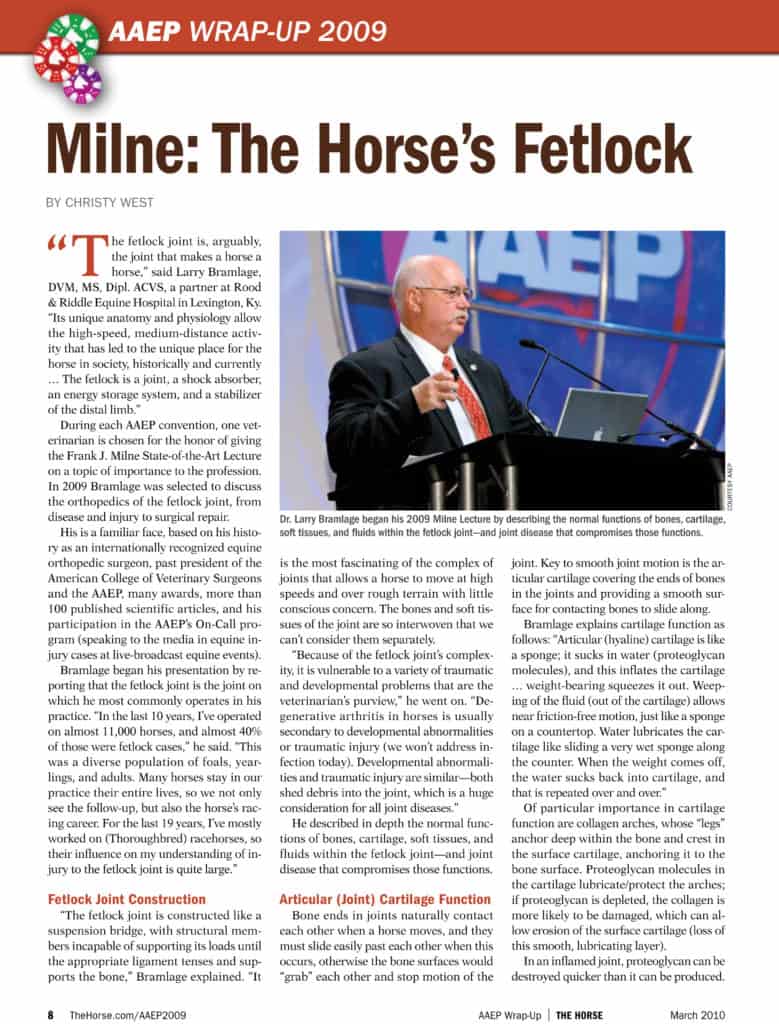Coronary Band Injuries in Horses
Horses are likely to sustain coronary band and hoof wall injuries at one time or another. These injuries can carry long-term performance and soundness consequences.
Horses are likely to sustain coronary band and hoof wall injuries at one time or another. These injuries can carry long-term performance and soundness consequences.

Dr. Kevin Haussler discusses horse back problems and the use of chiropractic and complementary therapies.
In a retrospective study of 118 French Trotters, a team of veterinarians found that horses with back pain had more severe and localized lesions identifiable on X ray than horses with no evidence of back pain, but even pain-free horses had lesio

During each convention of the American Association of Equine Practitioners, one veterinarian is chosen for the honor of giving the Frank J. Milne State-of-the-Art Lecture on a topic of importance to the profession. In 2009 Larry Bramlage, DVM, MS, Dipl. ACVS, was selected to discuss the orthopedics of the horse’s fetlock joint, from disease and injury to surgical repair.
Learn about the normal functions of bones, cartilage, soft tissues, and fluids within the fetlock joint.
In 2009 the AAEP Foundation conducted a survey to assess the thoughts and opinions of the membership in defining and prioritizing the needs for equine health research. This followed an initial survey in 2003 to establish needs for equine research…
Osteoarthritis of the distal (lower) hock joints is a common performance problem in sport horses.

Wobbler syndrome takes its name from its primary sign–a wobbling or uncoordinated gait. In technical terms, the horse has a “proprioceptiveness deficit,” or a lack of physical awareness of his limbs and their placement.
The force a rider exerts on the horse’s back will shift depending on his or her position and should be included in any evaluation of tack pressure, researchers recently reported.
“You need a force that is distributed over a certain area to
Learn how to keep splints (bony lower leg swellings) from becoming permanent blemishes or problems that interfere with a horse’s athletic career.
I purchased my Thoroughbred gelding when he was 5 years old. Within the next two years we were doing really
During a three-year study on articular (joint) cartilage maturation, researchers at the Gluck Equine Research Center used new genetic techniques to investigate how joint cartilage changes between newborn foals and young adult horses.
It is
One of the most common deformities that equine veterinarians deal with in newborns is contracted digital flexor tendons. This might cause foals to walk on the toes of their front hooves instead of being flat footed.
Results of a clinical study showed that distal limb wounds treated with a dressing containing esterified hyaluronic acid (hyaluronan) showed no improvement in healing as compared to untreated wounds.
To evaluate the effect of an
Researchers examined the effects of uneven feet on equine performance and linked this to other faults.
Austrian researchers have reported that the stability of a rider?s seat affects the forces acting on a horse?s back. Using an electronic pressure mat placed under a dressage saddle, scientists with the University of Veterinary Medicine Vienna?s
Stay on top of the most recent Horse Health news with
"*" indicates required fields